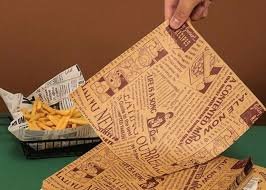When it comes to food presentation and packaging, the little details matter. One of those often-overlooked details is parchment paper. While most people think of it as just a functional kitchen item, businesses in the food industry know that custom parchment paper can transform how their brand is perceived. Whether you’re wrapping sandwiches, lining bakery boxes, or serving fries in a basket, a touch of personalization elevates your food presentation from ordinary to unforgettable.
In this guide, we’ll walk you through how to design parchment paper that not only looks amazing but also strengthens your branding and improves customer experience.
Why Custom Parchment Paper Matters
Think about the last time you unwrapped a sandwich or pastry. Did the paper have a clean, professional design—or was it just plain white? The difference is subtle but powerful. Branded parchment instantly communicates quality, professionalism, and attention to detail.
Here are a few reasons businesses invest in custom food wrapping paper:
- Brand Identity – Your logo, colors, and tagline reinforce your business identity with every wrapped item.
- Memorability – A custom design leaves a lasting impression, making customers more likely to remember and return.
- Professional Look – Even a simple logo on parchment elevates your food’s presentation.
- Marketing Value – Every food photo your customers share online becomes free advertising if your branding is front and center.
- Customer Trust – People often associate branded packaging with higher quality and safer handling.
Step 1: Define the Purpose of Your Custom Parchment Paper
Before jumping into design, ask yourself: How will this paper be used?
- For wrapping sandwiches and burgers → You’ll need grease-resistant parchment with bold, visible designs.
- For lining bakery boxes or trays → A lighter pattern works best, so the food still stands out.
- For serving fries, cookies, or pastries → Fun, playful prints or repeating logos keep things stylish.
Knowing the purpose ensures your design is not just attractive but also practical.
Step 2: Choose the Right Material and Size
Not all parchment paper is created equal. While designing is important, the paper’s performance matters just as much.
- Grease-resistant parchment – Prevents oils from seeping through. Perfect for burgers, sandwiches, and baked goods.
- Eco-friendly parchment – If your brand promotes sustainability, biodegradable parchment is a must.
- Bleached vs. unbleached – White parchment offers a clean canvas for vibrant designs, while natural parchment creates a rustic feel.
Size also plays a role. Small wrappers might only need a logo, while larger sheets allow for full patterns or brand storytelling.
Step 3: Design Elements to Consider
Now comes the fun part—designing your parchment. Here are key elements to focus on:
1. Logo Placement
Your logo is the centerpiece of your design. Many brands use a repeating logo pattern across the sheet, ensuring visibility no matter how the food is wrapped.
2. Typography
Adding a tagline, slogan, or brand message can make your parchment paper more engaging. Use fonts that align with your brand’s personality—modern, elegant, playful, or rustic.
3. Colors
Stick to your brand colors for consistency. However, remember that parchment is often semi-transparent. Black or dark-colored prints typically stand out best.
4. Patterns and Illustrations
If you want something beyond logos, consider icons, doodles, or food-themed illustrations. For example:
- Coffee shops might use sketches of coffee beans or cups.
- Bakeries can add illustrations of bread, cakes, or rolling pins.
- Burger joints may design with fries, buns, or sauce bottles.
5. Minimalism vs. Boldness
- Minimalist designs (simple logos, light patterns) work well for premium brands.
- Bold, playful prints are perfect for casual, fun eateries.
Step 4: Work with a Professional Designer or DIY
If you have design experience, you can create mockups using tools like Adobe Illustrator, Canva, or Photoshop. But if design isn’t your strength, hiring a professional ensures your parchment looks polished and print-ready.
When working with a designer, provide:
- Your logo files (preferably in vector format).
- Brand guidelines (colors, fonts, slogans).
- Inspiration examples (other packaging designs you admire).
Step 5: Print and Test
Once your design is ready, test-print a few samples before ordering in bulk. This lets you check:
- Print clarity (is your logo sharp and easy to read?).
- Ink visibility (do your colors look good on parchment?).
- Functionality (does the grease resistance hold up?).
Real-world testing with actual food ensures your parchment paper isn’t just beautiful—it works.
Creative Ideas for Custom Food Wrapping Paper
To spark inspiration, here are some creative uses for custom food wrapping paper:
- Seasonal Designs – Add holiday themes like snowflakes for Christmas or hearts for Valentine’s Day.
- Limited Edition Prints – Launch special designs for new menu items or collaborations.
- Interactive Wrappers – QR codes linking to menus, social media pages, or promotions.
- Storytelling Prints – Share your brand’s history, farm-to-table philosophy, or fun food facts right on the paper.
These ideas not only enhance presentation but also give your customers something to talk about—and share online.
Best Practices for Designing Custom Parchment Paper
- Keep it legible: Avoid overly complex designs that get lost when food is placed on top.
- Make it versatile: Your design should work for multiple menu items.
- Stay on-brand: Consistency across menus, packaging, and parchment builds stronger recognition.
- Test for practicality: The paper should withstand grease, moisture, and handling.
Final Thoughts
Designing custom parchment paper is more than just about wrapping food—it’s about creating an experience. From the moment your customer sees your packaging to the second they take their first bite, every detail adds to your brand story.
By carefully selecting materials, incorporating brand elements, and testing for functionality, you can turn a simple sheet of parchment into a powerful branding tool. And when used as custom food wrapping paper, it doesn’t just keep your food fresh and presentable—it makes your brand unforgettable.







